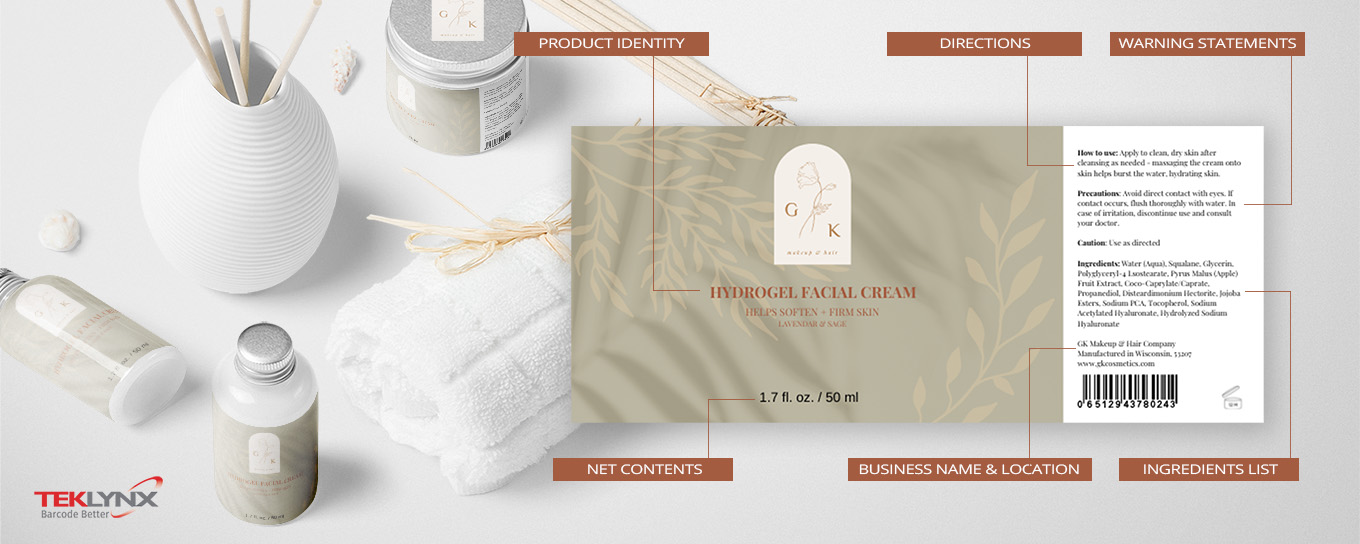Wybierz swoją lokalizację i język, aby korzystać z najlepiej przystosowanej strony internetowej
Wybierz swoją lokalizację i język, aby korzystać z najlepiej przystosowanej strony internetowej

The cosmetic industry faces strict labeling requirements to protect consumer safety and promote transparency. While the cosmetic space and the labeling regulations associated with it aren’t new, it’s a growing market. According to a 2022 report by Industry Research, the global Cosmetic Skin Care market was valued at $55 billion in 2020 and is expected to reach $89 billion million by the end of 2027, growing at a CAGR of 7.1% during 2021-2027.
In this blog, learn what qualifies as a cosmetic, the requirements for a cosmetic product label, and how to choose the best cosmetic labeling software.
The first step in labeling cosmetic products is answering the following question: is my product considered a cosmetic or a drug?
The US Federal Food, Drug, and Cosmetic Act (FD&C) defines cosmetics as “articles intended to be applied to the human body for cleansing, beautifying, promoting attractiveness, or altering the appearance without affecting the body's structure or functions.” This includes lotions, perfumes, shampoos, lipsticks, eye makeup, fingernail polish and more.
On the other hand, the FD&C defines drugs as “articles intended for use in the diagnosis, cure, mitigation, treatment, or prevention of disease" and "articles (other than food) intended to affect the structure or any function of the body.”
While there are two clearly separate definitions for drugs and cosmetics, they are not mutually exclusive; some products can be considered both a cosmetic and a drug. The difference comes down to the intent of the product: Is the product intended to cleanse or promote attractiveness, or does the product affect the structure or function of the body? For example, deodorant masks odor, but when antiperspirant is included, the function of the product alters your body by restraining sweat, classifying the product as both a cosmetic and drug. Shampoo cleans your hair, but anti-dandruff shampoo is also considered a drug because of the intended use of treating dandruff.
Classifying your product as a cosmetic, drug, or both is essential because it determines what is required on your label.
If your product is considered both a cosmetic and a drug, the product label must adhere to both sets of regulations.
To learn more about what is considered a cosmetic vs. a drug, see the FDA’s article, “Is It a Cosmetic, a Drug, or Both?”
There are three main categories of requirements on cosmetic product labels: the Principal Display Panel, the Information Display Panel, and other requirements related to formatting and use of language.

The PDP is the portion of the label that is most visible, and the part of the product that is facing outwards on a retail shelf (21 CFR 701.10). The PDP must include the following:
To see the full requirements of cosmetic labeling, see the FDA’s Cosmetic Labeling Guide.
When it comes to marketing and selling your cosmetics, having eye-catching product labels and packaging is crucial. But while your products need to stand out, they also are required to contain all the necessary information to stay compliant. You will need to choose cosmetic labeling software that can accommodate both the creative aspect of your cosmetic label by allowing high-res artwork, and the compliant aspect by allowing warning symbols, statements, and ingredient lists.
Typically, cosmetic products come in various sizes, shades, or scents. This means one cosmetic product, such as a lip balm, might need to have identical labels apart from having different scents. Instead of creating 10 separate labels to change the scent name, your cosmetic labeling software should give you the ability to design label templates where you only need one label template with variable fields.
Since cosmetics labels have mandated requirements by the FDA, it’s critical that your cosmetic labeling software keeps your labels protected from unwanted changes. If someone who isn’t familiar with cosmetic labeling requirements decreases text size, deletes a warning statement, or moves an element on the label, this could qualify your product as mislabeled or misbranded.
When you need to design cosmetic product labels that are compliant and stand out, CODESOFT is the best label design software to meet your needs. CODESOFT supports all common file formats, including .jpg, .png, .gif, .eps, .tif, .bmp, .pdf, which gives you the ability to import any artwork. Either import your artwork as a background image that is static to your label templates or import your artwork as variable images that automatically populate with each product type or variety. Learn more about how to make your product labels stand out in our blog.
Smart label templates in CODESOFT enable you to minimize the number of label files and increase efficiency and speed in your labeling process. Instead of having countless separate label files for each product variety, scent, or shade, simply create one label template that pulls in variable information from a database or spreadsheet. To learn more about creating database connections in CODESOFT, watch our webinar Creating Database Connections with TEKLYNX Software.
Learn more about CODESOFT or download a free 30-day trial.
To keep your labels protected from unwanted changes, LABEL ARCHIVE is the best cosmetic labeling software for security. LABEL ARCHIVE integrates with CODEOSFT and gives you the ability to set up a custom label approval process, ensuring all cosmetic product labels are approved and compliant before sending to print. Through user permissions, ensure only authorized users can edit or print labels, so labels don’t become non-compliant through an unintended edit. If a labeling mistake is made such as printing the wrong label or changing a label template, LABEL ARCHIVE offers a full traceability audit and version history to pinpoint the exact date, time, location, and user to give a diagnosis of the error.
Learn more about LABEL ARCHIVE or request a demo.
If you want to learn more about our cosmetic labeling software or how to make your cosmetic product labels compliant, talk to one of our labeling experts.
Jenna Wagner, Global Marketing Director, is a successful strategic marketing executive with over 20 years of marketing experience in software technology and consulting services. She is a creative, dynamic, results-driven leader who possesses a passion for developing her teams. She leverages her deep understanding of the solutions and industries she serves to deliver impactful customer value throughout the global supply chain to help organizations barcode better.
You’ve created a great product and made it to store shelves! Your hard work is starting to pay off, and now it’s time to make sure you’re setting your product up for the commercial success it deserves. Designing an attractive and professional product label is the best way to make sure your product stands out, and images are a great way to do just that.
READ MORE
Everyone wants to do better. Whether it’s improving your health, career, or home, there’s always room to do things better. Well, what if I told you there’s a better way to design your barcode labels?
READ MORE
According to the Enterprisers Project, security must be a top priority for technology executives in 2022. Building a secure barcode labeling process is an important piece of a company’s security strategy that has a direct impact on the bottom line.
Mislabeling is one of the top causes of recalls in the United States, and labeling errors stem from gaps in labeling security. This blog will discuss ways to create a managed, controlled, and secure barcode labeling process leveraging better connections between people, software, and process.
READ MORE© Copyright 2025 TEKLYNX CORPORATION SAS. Wszystkie prawa zastrzeżone.
What do you think? Leave us a comment.
Comments will be reviewed and are subject to TEKLYNX’ comment policy. Your email address will not be published publicly.